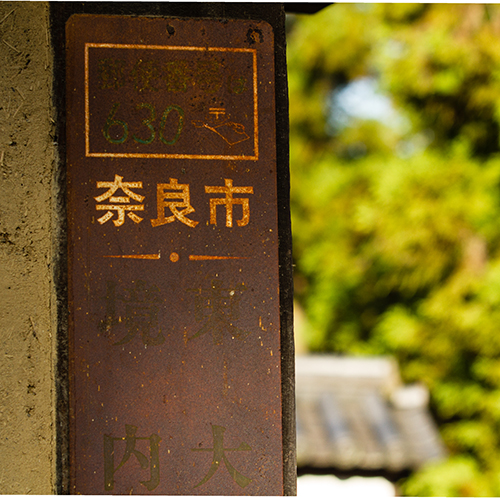138. The "Stopping" Radical: 艮
The "stopping" radical 艮 strongly resembles the following kanji, but they do differ:
良 (598: good; allowable)
Unlike 良, the six-stroke 艮 has no dot on top.
Let's look at the etymology of 良, the sole Joyo kanji classified under our radical. Henshall says in his newer edition that old forms of 良 depict "some sort of receptacle for pouring material in to measure, then letting it out." He notes that one researcher takes this container to be a vessel holding food, whereas another perceives it as a sieve. These experts disagree about whether "good" is loan usage or an extended sense. Either way 良 strikes me as having an etymological tie to this radical:
radical 184: 食 (food)
Just for fun, click on that link and check out the third photo, the one with German text. The sign contains 艮 as a mere component in 限 (665: limit), creating a contrast with two instances of the "food" radical in 飲み食い. That word features both 食 and its variant.

Photo Credit: Samuel
The 良 kanji pops up in the place name 奈良市 (ならし: Nara City). This city is in a prefecture of the same name on Honshu.
Northeast in the Zodiac
Our radical matches the shape of this non-Joyo kanji:
艮 (うしとら: northeast)
In this archaic word (primarily rendered as 丑寅, in which both kanji are non-Joyo), the definition refers to the Chinese zodiac. In that system, known as 十二支 (じゅうにし), the 12 zodiacal signs are arranged like numbers on a clock, where 子 represents 0:00, 丑 stands for 1:00, and 寅 symbolizes 2:00. Thus, 丑寅 means 1:30, as does 艮.
As you can see in a diagram on Wikipedia, 0:00 is at the bottom, where 6:00 ordinarily is. That is also where north is located, whereas east aligns with 3:00 (in the place we're accustomed to seeing 9:00). Therefore, 艮 correlates with northeast. A chart on another site makes the connection with the cardinal directions much clearer than the Wikipedia diagram does.
The Names of the 艮 Radical
If you read 艮 as ゴン or コン, it means "stopping"—hence, the English name of this radical. But the Japanese hardly ever use 艮 alone, and in all likelihood, few people realize that it means that.
Two yomi of 艮 give rise to these Japanese names for our radical:
うしとら
こん
こんづくり
With 良 (598: good; allowable), the radical name うしとら works fine, and こん would make sense, not こんづくり.
That last name applies only when the radical is on the right side of a kanji. (For more on this, see Radical Terms, go to the "Radical Positions" section, and read about Position 2, -つくり. The next section, "Radical Names," notes that voicing changes -つくり to -づくり.)
We don't need こんづくり for any Joyo kanji. Though 艮 occupies the right side of the following Joyo kanji, the left-side component serves as the radical in every case:
銀 (263: silver)
眼 (640: eye)
限 (665: limit)
恨 (1277: grudge)
Nelson supplies the alternate radical name ねづくり, identifying 艮 as the right side of 根 (282: root), which carries the Joyo kun-yomi ね. The name ねづくり may be helpful for reference, but it is inaccurate, as 木 (radical 75: "tree") is the on-duty radical of 根.
Is There a Variant?
Well, what about the left sides of these kanji, in which the right-side components are the on-duty radicals:
既 (1126: already)
即 (1534: immediate)
Nelson says that in those situations, the five-stroke version of our radical constitutes a variant. I disagree, siding instead with sources asserting that 艮 has no variant.
In the original shapes of 既 and 即—respectively, 既 and 卽—the left sides looked nothing like 艮. Henshall etymologically connects the left sides of those early shapes with food piled high on vessels, suggesting to me a link to 食, not 艮. The current left sides were created somewhere between 1946 (when the list of Toyo kanji was issued, reflecting old forms of the two kanji) and 1981 (when the first Joyo set came into being, featuring the contemporary shapes of 既 and 即).
Photo Credit: Sui Feng
In addition to 奈良, our 艮 radical appears in several notable place names, including 銀座 (ぎんざ: a posh section of Tokyo) and 箱根 (はこね: a mountainous town in Kanagawa Prefecture known for hot springs and scenery). The former name appears here, preceding 土 (dirt)! It is completely unclear what 土 contributes to this sign! I also have no idea why this 土 appears to have an extraneous stroke.
